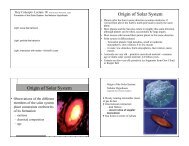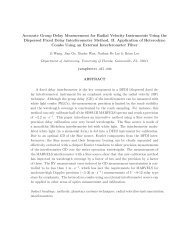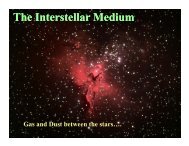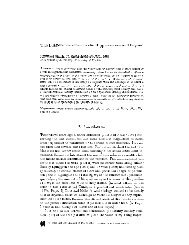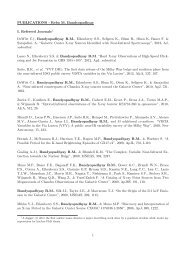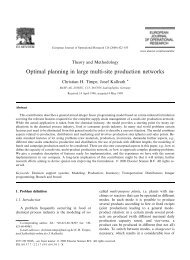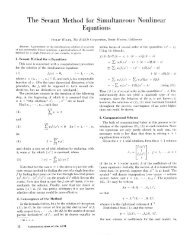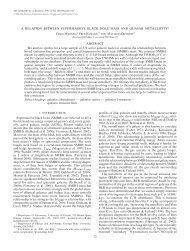the universe - Department of Astronomy - University of Florida
the universe - Department of Astronomy - University of Florida
the universe - Department of Astronomy - University of Florida
You also want an ePaper? Increase the reach of your titles
YUMPU automatically turns print PDFs into web optimized ePapers that Google loves.
The resulting observations with <strong>the</strong>se instrumentshave led to groundbreaking discoveriesby UF astronomers - in areas ranging from<strong>the</strong> birth <strong>of</strong> <strong>the</strong> Universe to <strong>the</strong> developmentand detection <strong>of</strong> new planets.These successes positioned <strong>the</strong> UF <strong>Department</strong><strong>of</strong> <strong>Astronomy</strong> to become apartner with <strong>the</strong> Spanish and Mexicangovernments in building <strong>the</strong> world’slargest telescope, <strong>the</strong> Gran TelescopioCanarias, located in <strong>the</strong> Canary Islands.The projects discussed here are just a sample<strong>of</strong> <strong>the</strong> cutting edge astronomy research beingconducted at <strong>the</strong> <strong>University</strong> <strong>of</strong> <strong>Florida</strong>. Newprojects and programs are constantly emergingas <strong>the</strong> <strong>Department</strong> <strong>of</strong> <strong>Astronomy</strong> continues itswork at <strong>the</strong> forefront <strong>of</strong> <strong>the</strong> field.The Gran Telescopio Canarias (GTC) at Observatorio del Roquede los Muchachos on <strong>the</strong> island <strong>of</strong> La Palma, Canary IslandsUF <strong>Astronomy</strong>:Forming Partnerships For DiscoveryThe goal <strong>of</strong> <strong>the</strong> UF <strong>Department</strong> <strong>of</strong> <strong>Astronomy</strong>is to become one <strong>of</strong> <strong>the</strong> top 10 pub-astronomical instrumentation.in astronomical research and, in particular,lic astronomy departments in <strong>the</strong> United In <strong>the</strong> coming years, <strong>the</strong> <strong>Department</strong>States. Thanks to strong support from <strong>the</strong> <strong>of</strong> <strong>Astronomy</strong> is continuing to grow and<strong>University</strong>, outstanding faculty and strong broaden <strong>the</strong> research opportunities at <strong>the</strong>international collaborations, we are well <strong>University</strong> <strong>of</strong> <strong>Florida</strong>. Several key initiativesare already underway. For instance,on our way to achieving this goal. We havepartnered with astronomers in Spain and UF is playing a key role in <strong>the</strong> developmentMexico to build <strong>the</strong> world’s largest optical <strong>of</strong> instrumentation for <strong>the</strong> proposed $1-billionThirty Meter Telescope (TMT) project.telescope, <strong>the</strong> GTC. This 10.4-meter telescopeis being constructed in <strong>the</strong> Canary A team <strong>of</strong> nine UF faculty, led by Pr<strong>of</strong>essorIslands and will begin operation in 2008. Stephen Eikenberry, have been competitivelyselected to develop detailed scien-The superb image quality will allow <strong>the</strong> GTCto “see” both <strong>the</strong> faintest and <strong>the</strong> most distantobjects in <strong>the</strong> <strong>universe</strong>—from nearby, for <strong>the</strong> top-priority science instrument ontific observation simulations and designsnewborn planets and stars, to <strong>the</strong> most distantgalaxies.graph (IRMOS). IRMOS will be <strong>the</strong> work-TMT, <strong>the</strong> InfraRed Multi-Object Spectro-The formation and evolution <strong>of</strong> planets,stars and galaxies is <strong>the</strong> major unify-world’s most powerful tool for investigatinghorse spectrograph for TMT, and will be <strong>the</strong>ing research <strong>the</strong>me <strong>of</strong> our department, and many astrophysical phenomena, includingwe are pursuing that <strong>the</strong>me through related “Cosmic Dawn”—<strong>the</strong> birth <strong>of</strong> <strong>the</strong> first starsobservational, <strong>the</strong>oretical and instrumentationresearch programs. Our partnership research spectrum, Pr<strong>of</strong>essor Jian Ge andafter <strong>the</strong> Big Bang. At <strong>the</strong> o<strong>the</strong>r end <strong>of</strong> <strong>the</strong>with Spain and Mexico has led to <strong>the</strong> development<strong>of</strong> new instruments that will be <strong>the</strong> next steps in planet searching with <strong>the</strong>incoming UF Pr<strong>of</strong>essor Eric Ford are leadingused to achieve <strong>the</strong> research goals <strong>of</strong> <strong>the</strong> All-Sky Extra-Solar Planet Survey (ASEPS).department, such as CanariCam, FRIDA (InfraredAdaptive Optics Integral Field Unit) Tracker instruments developed at UF toASEPS will use a number <strong>of</strong> Exoplanetand CIRCE (Canarias Infrared Camera Experiment).UF astronomers are also partners in around nearby stars, revolutionizing thisfind hundreds to thousands <strong>of</strong> new planetsGOYA, a major near-infrared spectroscopic area <strong>of</strong> study.survey to be carried out on <strong>the</strong> GTC to study Through our programs, partnershipsgalaxy formation and evolution. In addition, and future endeavors, <strong>the</strong> <strong>University</strong> <strong>of</strong>UF has implemented a very successful programto bring Spanish graduate students upward trajectory <strong>of</strong> distinction that we be-<strong>Florida</strong>’s <strong>Astronomy</strong> <strong>Department</strong> is on anand young postdocs to acquire expertise lieve is limited only by our imagination.<strong>Department</strong> ChairPr<strong>of</strong>essor Stanley Dermott<strong>Department</strong> <strong>of</strong> <strong>Astronomy</strong>211 Bryant Space Science CenterPO Box 112055Gainesville FL 32611-2055Phone: (352) 392-2052Fax: (352) 392-5089www.astro.ufl.edudiscovering <strong>the</strong> <strong>universe</strong><strong>Department</strong> <strong>of</strong> <strong>Astronomy</strong>The <strong>University</strong> <strong>of</strong> <strong>Florida</strong> has taken aunique approach to building one<strong>of</strong> <strong>the</strong> nation’s top astronomyprograms.The <strong>Department</strong> <strong>of</strong> <strong>Astronomy</strong> hasbeen able to gain extensive observingtime on <strong>the</strong> world’s most powerfultelescopes by becoming one <strong>of</strong> <strong>the</strong>premiere centers for astronomicalinstrumentation.The instruments built at UF addressa variety <strong>of</strong> important areasin science. Infrared cameras constructedat <strong>the</strong> university are beingused to investigate a wide range<strong>of</strong> astrophysical objects, includingstar-forming regions, circumstellardisks, starbursts and active galaxies.Meanwhile, o<strong>the</strong>r devices createdat UF focus on detecting exosolarplanets.Front Cover:Orion Nebula from <strong>the</strong> Hubble SpaceTelescope Orion Treasury Project Team(top) and a galaxy cluster image from<strong>the</strong> ESO Distant Cluster Survey (bottom)
Pr<strong>of</strong>essor Jian GeDistant Worlds & Their OriginsWith <strong>the</strong> first detection in 1995 <strong>of</strong> a planetorbiting ano<strong>the</strong>r Sun-like star, a new and excitingera <strong>of</strong> astronomy began. To date, morethan 180 such exosolar planets have beenfound, mainly using <strong>the</strong> “radial velocity (RV)technique” that measures <strong>the</strong> small backand-forthmotion <strong>of</strong> a star in response to <strong>the</strong>tug <strong>of</strong> unseen planets. Pr<strong>of</strong>essor Jian Ge andhis team are on <strong>the</strong> verge <strong>of</strong> revolutionizingthis field by implementing a new approachto RV measurements. The Exoplanet Tracker,or ET for short, permits observations <strong>of</strong> manystars at once using wide field telescopes suchas <strong>the</strong> Sloan Digital Sky Survey’s 2.5-metertelescope at Apache Point Observatory. Bygreatly increasing <strong>the</strong> discovery rate <strong>of</strong> exosolarplanets, this technique promises to lay<strong>the</strong> groundwork for a much broader appreciation<strong>of</strong> <strong>the</strong> variety <strong>of</strong> distant worlds beyondour solar system.Pr<strong>of</strong>essor Ge’s team recently achieved amajor milestone in this quest with <strong>the</strong> discovery<strong>of</strong> a planet, ET-1, found with <strong>the</strong>ir ET prototypeinstrument at Kitt Peak National Observatory.The planet has half <strong>the</strong> mass <strong>of</strong> Jupiterand orbits its partner star every 4.1 days. InGe’s words, “This approach promises to discoverthousands <strong>of</strong> planetary systems aroundSun-like stars, as well as hundreds <strong>of</strong> systemsaround low-mass stars in <strong>the</strong> solar neighborhoodthat could host life.”ET Comes HomeFunded by <strong>the</strong> W.M. Keck Foundation, <strong>the</strong>Keck Exoplanet Tracker (ET) is <strong>the</strong> first ina new generation <strong>of</strong> Doppler instruments used fordetecting exosolar planets. This innovative approach,which is completely different from traditionalDoppler techniques, opens up a new capabilityfor simultaneous precision radial velocity measurements<strong>of</strong> many stars.How planets like Earth and those detected byPr<strong>of</strong>essor Ge form and evolve is a problem beingaddressed by Pr<strong>of</strong>essors Stanley Dermott,Bo Gustafson and Charles Telesco. The disks<strong>of</strong> gas and dust that surround many <strong>of</strong> <strong>the</strong>stars in our <strong>universe</strong> are nurseries for newlyborn planets and provide natural laboratoriesfor observing <strong>the</strong> evolution <strong>of</strong> planetary systems.Light from <strong>the</strong> star is scattered by <strong>the</strong>dust particles in <strong>the</strong>se disks and <strong>the</strong> properties<strong>of</strong> <strong>the</strong>se particles are investigated byPr<strong>of</strong>essor Gustafson using replica particles inhis unique Microwave Analog to Light ScatteringFacility. The dust particles are also heatedby <strong>the</strong> starlight incident upon <strong>the</strong>m and glowwith infrared radiation that is captured byelectronic cameras like <strong>the</strong> T-ReCS and CanariCamthat were designed and built at UF byPr<strong>of</strong>essor Telesco’s team.In addition, <strong>the</strong> disks will interact with anyplanetary systems embedded within <strong>the</strong>m toproduce telltale signatures that indicate <strong>the</strong>irexistence. Pr<strong>of</strong>essor Dermott and his colleagueDr. Thomas Kehoe have developedmodels using <strong>the</strong>oretical techniques and numericalsimulations that link <strong>the</strong> structure observedin some disks to <strong>the</strong> presence <strong>of</strong> suchunseen planets. For some stars, <strong>the</strong> imagesreveal intriguing structures that may insteadbe due to single cataclysmic events. The luminousdisk surrounding <strong>the</strong> 20-million-year-old“Beta Pictoris” star contains a bright clump <strong>of</strong>particles that could have resulted from <strong>the</strong>catastrophic collisional disruption <strong>of</strong> a smallplanet hundreds-to-thousands <strong>of</strong> kilometersin size. “We may have captured, for <strong>the</strong> firsttime, <strong>the</strong> image <strong>of</strong> a major, highly energeticevent that must have occurred manytimes in <strong>the</strong> early history <strong>of</strong> our ownsolar system, and could even havebeen responsible for <strong>the</strong> creation<strong>of</strong> our own moon,” Telesco says.Planetary disk around<strong>the</strong> nearby star BetaPictoris imaged withT-ReCST-Recs:Thermal-RegionCamera andSpectrographT-ReCS, built by Pr<strong>of</strong>essor CharlesTelesco and his team, and <strong>the</strong> firstmajor facility-class instrumentto be built in <strong>the</strong> Infrared InstrumentationLaboratory, has beenfully operational since 2003 at <strong>the</strong>Gemini South 8-meter telescopein Chile. It is optimized for observations<strong>of</strong> <strong>the</strong>rmal-infrared (heat)radiation that dominates <strong>the</strong> radiationoutput from relatively coolcelestial objects and is nearly imperviousto interstellar extinction.This highly productive imager andspectrograph is now being usedby <strong>the</strong> international community <strong>of</strong>astronomers to search for planetsand brown dwarfs, explore planetformingcircumstellar disks andprobe visually obscured star-formingregions and <strong>the</strong> hidden cores <strong>of</strong>galaxies.Pr<strong>of</strong>essor Jonathan TanStars: From Cradle to GraveJust like people, stars experience birth, middle-age,senior citizenship and, eventually,death. The lifespan <strong>of</strong> stars can be as shortas a few million years, and yet some are almostas old as <strong>the</strong> <strong>universe</strong> itself. Researchersin <strong>the</strong> UF <strong>Department</strong> <strong>of</strong> <strong>Astronomy</strong> areactively studying stars in a variety <strong>of</strong> lifestages—from <strong>the</strong> cradle to <strong>the</strong> grave.Pr<strong>of</strong>essors Elizabeth Lada and JonathanTan use observational and <strong>the</strong>oreticalmethods, respectively, to aid in <strong>the</strong>ir study<strong>of</strong> <strong>the</strong> birth <strong>of</strong> stars and planetary systems.They are particularly curious about how thisprocess changes across different areas <strong>of</strong><strong>the</strong> <strong>universe</strong>—from <strong>the</strong> crowded centers <strong>of</strong>star clusters like <strong>the</strong> nearby Orion Nebula to<strong>the</strong> swirling disks <strong>of</strong> gas around mysteriousblack holes in <strong>the</strong> centers <strong>of</strong> galaxies. “Ourstudies <strong>of</strong> star formation have determinedthat <strong>the</strong> first stars in <strong>the</strong> <strong>universe</strong> were verymassive, about 200 times that <strong>of</strong> our Sun,”notes Pr<strong>of</strong>essor Tan. “Fur<strong>the</strong>rmore, it appearsthat massive stars form via <strong>the</strong> samemechanism as lower-mass stars, namely<strong>the</strong> collapse <strong>of</strong> a gas core to an accretiondisk, which <strong>the</strong>n channels gas to <strong>the</strong> star.”Stars in <strong>the</strong>ir middle to senior years <strong>of</strong>age are <strong>the</strong> focus <strong>of</strong> Pr<strong>of</strong>essor Ata Sarajedini’sresearch efforts. He is not only interestedin <strong>the</strong> properties <strong>of</strong> <strong>the</strong> stars <strong>the</strong>mselves,but he is also using stars within <strong>the</strong> context<strong>of</strong> <strong>the</strong>ir parent galaxies to understand <strong>the</strong>process <strong>of</strong> galaxy formation and evolution.“Using stars as tools, we are increasinglyconfident that large galaxies like our ownMilky Way are formed through <strong>the</strong> disruptionand eventual destruction <strong>of</strong> smallergalaxies,” says Sarajedini. “Fur<strong>the</strong>rmore,<strong>the</strong> age <strong>of</strong> <strong>the</strong> oldest stars—such as those inglobular clusters—sets a lower limit on <strong>the</strong>Flamingos Survey Serpens Imageage <strong>of</strong> <strong>the</strong> <strong>universe</strong>, which has broad implicationsfor cosmology.”When stars reach <strong>the</strong> end <strong>of</strong> <strong>the</strong>ir lives,<strong>the</strong> more massive ones form such exoticobjects as neutron stars and black holes.These remnants <strong>of</strong> stellar evolution are <strong>the</strong>focus <strong>of</strong> Pr<strong>of</strong>essor Stephen Eikenberry andDr. Reba Bandyopadhyay’s work. When one<strong>of</strong> <strong>the</strong>se stellar remnants interacts in an orbitwith a normal star, spectacular and violentfireworks can result. Studying <strong>the</strong> details<strong>of</strong> this phenomenon can shed light onboth <strong>the</strong> most extreme physical conditionsin <strong>the</strong> <strong>universe</strong> and on <strong>the</strong> nature <strong>of</strong> <strong>the</strong>most massive stars in <strong>the</strong> galaxy. Pr<strong>of</strong>essorEikenberry summarizes his work by noting,“Our group focuses on <strong>the</strong> biggest, <strong>the</strong> hottestand <strong>the</strong> fastest things <strong>the</strong>re are.”Flamingos: <strong>Florida</strong> Multi-object ImagingNear-IR Grism Observational SpectrometerMost stars in our galaxy form in Giant Molecular Clouds (GMCs), yet we still don’t fully understand <strong>the</strong> process <strong>of</strong> star formation inthis environment. Pr<strong>of</strong>essor Elizabeth Lada, Dr. Nick Raines and <strong>the</strong>ir group are using FLAMINGOS, <strong>the</strong> world’s first fully cryogenic,near-infrared multi-object spectrometer, to learn in detail about <strong>the</strong> birth <strong>of</strong> stars in <strong>the</strong>se clouds. FLAMINGOS <strong>of</strong>fers unparalleledcapabilities for this research, enabling Lada’s team to observe dozens <strong>of</strong> stars at a time. This group is currently conducting a largesurvey that will address such fundamental issues as how star formation and <strong>the</strong> initial mass function vary between different cloudsand how star formation changes with time within a cloud.Flamingos-IIOn large modern telescopes,observational timecan cost more than $1 per second. With target objects numberingin <strong>the</strong> billions, FLAMINGOS-2, built by Pr<strong>of</strong>essor StephenEikenberry’s team at UF which includes Dr. Reba Bandyopadhyayand Dr. Nick Raines, <strong>of</strong>fers astronomers a hundred-fold increasein <strong>the</strong> number <strong>of</strong> objects <strong>the</strong>y can study at a time—greatlyimproving <strong>the</strong> “bang for <strong>the</strong> buck” scientific performance <strong>of</strong>modern observatories.Traditional methods provide for observations <strong>of</strong> one star orgalaxy at a time, but, using techniques pioneered at <strong>the</strong> <strong>University</strong><strong>of</strong> <strong>Florida</strong> with <strong>the</strong> FLAMINGOS instrument by <strong>the</strong> late Pr<strong>of</strong>essorRichard Elston, FLAMINGOS-2 can ga<strong>the</strong>r infrared spectroscopicdata on up to 120 such objects simultaneously on <strong>the</strong>world-class Gemini Observatory 8-meter telescopes. Surveys<strong>of</strong> <strong>the</strong> cosmos, which used to be prohibitively expensive for astronomersto undertake, can now be accomplished in just a fewnights <strong>of</strong> observation.The FLAMINGOS-2 Early Science Surveys (f2ESS), led byPr<strong>of</strong>essor Eikenberry and eight o<strong>the</strong>r UF faculty, will probe suchdiverse topics as <strong>the</strong> black hole population and history<strong>of</strong> <strong>the</strong> Galactic Center region, <strong>the</strong> evolution<strong>of</strong> galaxies early in <strong>the</strong> life <strong>of</strong> <strong>the</strong> Universe, <strong>the</strong>formation <strong>of</strong> stars in <strong>the</strong> Milky Way and <strong>the</strong>birth <strong>of</strong> <strong>the</strong> first galaxies after <strong>the</strong> BigBang. FLAMINGOS-2 is u n -dergoing final laboratorytesting at UFand is scheduled for“first light” observationsat <strong>the</strong> GeminiSouth Observatoryon Cerro Pachon,Chile, in late2006.Unlocking <strong>the</strong> Mysteries <strong>of</strong> <strong>the</strong> CosmosHow do galaxies like our own Milky Way formand evolve? Answering this question is at <strong>the</strong>core <strong>of</strong> extragalactic research at <strong>the</strong> <strong>University</strong><strong>of</strong> <strong>Florida</strong>.It has become quite clear to <strong>the</strong> scientificcommunity in recent years that supermassiveblack holes, which lie at <strong>the</strong> center <strong>of</strong>all galaxies, play an important role in galaxyevolution. Galaxies where material is flowinginto <strong>the</strong> central black hole and producingenormous amounts <strong>of</strong> light and energy arePr<strong>of</strong>essor Anthony Gonzalez and a galaxy clusterimage showing X-ray emission contoursknown as active galaxies. Pr<strong>of</strong>essors VickiSarajedini and Fred Hamann, along with Dr.Chris Packham, study <strong>the</strong>se active galaxiesin hopes <strong>of</strong> better understanding how <strong>the</strong>ychange over time and alter <strong>the</strong> properties<strong>of</strong> <strong>the</strong>ir host galaxies. Hamann’s researchfocuses on <strong>the</strong> most luminous type <strong>of</strong> activegalaxies known as quasars. These objects,a trillion times brighter than <strong>the</strong> Sun, arevisible from billions <strong>of</strong> light years away. Hamann’swork focuses on <strong>the</strong> early evolution<strong>of</strong> both <strong>the</strong> quasars and <strong>the</strong>ir host galaxies.Packham, in collaborationwith Spanishastronomers,is studying<strong>the</strong>innerPr<strong>of</strong>essor Stephen Eikenberry holding<strong>the</strong> Flamingos-2 infrared detectorregions <strong>of</strong> such objects in unprecedenteddetail using T-ReCs and Canaricam. Sarajediniis currently using <strong>the</strong> Hubble Space Telescopeto conduct deep field surveys to identifyvery faint emissions from active galaxiesin <strong>the</strong> distant <strong>universe</strong>. She is studying severalthousand galaxies to determine whe<strong>the</strong>r<strong>the</strong>ir central luminosity has changed overtime. “While <strong>the</strong> fainter active galaxies canbe difficult to detect, understanding <strong>the</strong>irproperties sheds light on <strong>the</strong> critical link betweenactive and normal galaxies” she says.Pr<strong>of</strong>essors Rafael Guzman and AnthonyGonzalez are examining <strong>the</strong> growth and starformation histories <strong>of</strong> galaxies and how <strong>the</strong>environment in which a galaxy resides affects<strong>the</strong>se properties. Pr<strong>of</strong>essor Guzman’sresearch focuses on understanding a type<strong>of</strong> galaxy that was once common in <strong>the</strong> <strong>universe</strong>but today is very rare—luminous bluecompact galaxies. By studying how <strong>the</strong>segalaxies evolve his research addresses howmodern galaxies, like our own Milky Way,are formed. Pr<strong>of</strong>essor Gonzalez also has hisgaze fixed on <strong>the</strong> distant <strong>universe</strong>. He hasdiscovered some <strong>of</strong> <strong>the</strong> most distant galaxyclusters known and is currently studying how<strong>the</strong>ir high-density environments influencegalaxy evolution.<strong>Astronomy</strong> for <strong>the</strong> PeopleThe department is involved in a wide range <strong>of</strong> public outreach activities designedto bring <strong>the</strong> wonders <strong>of</strong> astronomy to <strong>the</strong> general public. The campus obervatoryhosts open nights throughout <strong>the</strong> year, allowing visitors to view night-sky objectsthrough several telescopes. Many <strong>of</strong> <strong>the</strong> department’s pr<strong>of</strong>essors, postdoctoral researchersand students visit local schools to present astronomy-related activities to children. The departmentruns teacher training workshops in <strong>the</strong> summer and recently worked closely with local <strong>of</strong>ficialsto help <strong>the</strong> school board obtain a $1.1-million grant to provide science training for teachers. TheStarLab Portable Planetarium is being used in kindergarten through 12th grade classrooms acrossNorth Central <strong>Florida</strong> to get <strong>the</strong> astronomers <strong>of</strong> tomorrow excited about science. They learn about<strong>the</strong> nature <strong>of</strong> stars and galaxies, <strong>the</strong> making <strong>of</strong> comets, our solar system and <strong>the</strong> Milky Way galaxy.The department also sponsors an annual “museum night” at <strong>the</strong> local natural history museum,where <strong>the</strong> public is invited to hear lectures and enjoy many <strong>of</strong> <strong>the</strong> activities presented at schools.The GOYA Survey: Exploring The Early Universe“Astronomers are <strong>the</strong> ultimate explorers,”says Pr<strong>of</strong>essor Rafael Guzman. “Each newastronomical instrument launches an expeditionto explore <strong>the</strong> unknown with <strong>the</strong>expectation <strong>of</strong> newd i s c o v e r i e sahead.” Incosmology,<strong>the</strong>se expe d i -t i o n sa r etrips through <strong>the</strong> vastness <strong>of</strong> space to <strong>the</strong>beginning <strong>of</strong> time. The new generation <strong>of</strong>large telescopes like <strong>the</strong> GTC allows observations<strong>of</strong> galaxies that are very faint because<strong>the</strong>y are very far away. Since <strong>the</strong> larger<strong>the</strong> distance <strong>the</strong> longer it takes for light totravel from <strong>the</strong> object to <strong>the</strong> observer, GTCobservations <strong>of</strong> very distant galaxies willreveal how <strong>the</strong> <strong>universe</strong> looked like when itwas only one tenth <strong>of</strong> its current age.The exploration <strong>of</strong> <strong>the</strong> early <strong>universe</strong>is <strong>the</strong> focus <strong>of</strong> <strong>the</strong> UF Key Project: GalaxyOrigins and Young Assembly (GOYA). TheGOYA survey is being carried out by a team<strong>of</strong> astronomers at UF in collaboration withastronomers from Spain, Mexico and twoPr<strong>of</strong>essor Vicki Sarajedini and <strong>the</strong>Starlab portable planetariumo<strong>the</strong>r European countries. “GOYA will provide<strong>the</strong> most complete characterization<strong>of</strong> <strong>the</strong> optical properties <strong>of</strong> galaxies at <strong>the</strong>earliest epoch <strong>of</strong> <strong>the</strong> <strong>universe</strong> explored thusfar,” says Pr<strong>of</strong>essor Guzman, co-PrincipalInvestigator for <strong>the</strong> GOYA team. This surveyis unique in <strong>the</strong> unparalleled access to<strong>the</strong> best instruments ever built for exploring<strong>the</strong> early <strong>universe</strong>: EMIR (built in Spain)and FLAMINGOS-2 (built at UF) at <strong>the</strong> GTC.Using <strong>the</strong>se instruments, astronomers from<strong>the</strong> GTC partner institutions will be able tomap <strong>the</strong> distribution <strong>of</strong> matter in <strong>the</strong> early<strong>universe</strong>, classify its galaxy population andtest our current ideas about <strong>the</strong> geometryand <strong>the</strong> fate <strong>of</strong> <strong>the</strong> <strong>universe</strong> itself.CanariCamCanariCam, led by PI Pr<strong>of</strong>essor charles Telesco and Deputy PI Dr. ChrisPackham, is currently being completed in <strong>the</strong> UF Infrared InstrumentationLaboratory and will be available for use on <strong>the</strong> GranTelescope Canarias on its first day <strong>of</strong> operations. Like T-ReCS,CanariCam is optimized for imaging and spectroscopy in <strong>the</strong><strong>the</strong>rmal-infrared spectral region, but it will also have twocompletely new modes <strong>of</strong> operation: coronagraphy andpolarimetry. For <strong>the</strong> coronagraphic mode, special occultingand pupil masks suppress a star’s light by anPr<strong>of</strong>essor Rafael Guzmanorder <strong>of</strong> magnitude to enable astronomers to detectfaint objects such as giant planets or brown dwarfsthat may orbit a bright star. The polarimetric capability will provide a unique probe <strong>of</strong> accretion disks associatedwith heavily obscured massive black holes found at <strong>the</strong> center <strong>of</strong> most galaxies and it will illuminatepreviously inaccessible properties <strong>of</strong> particles orbiting in circumstellar disks where planets are formed.



